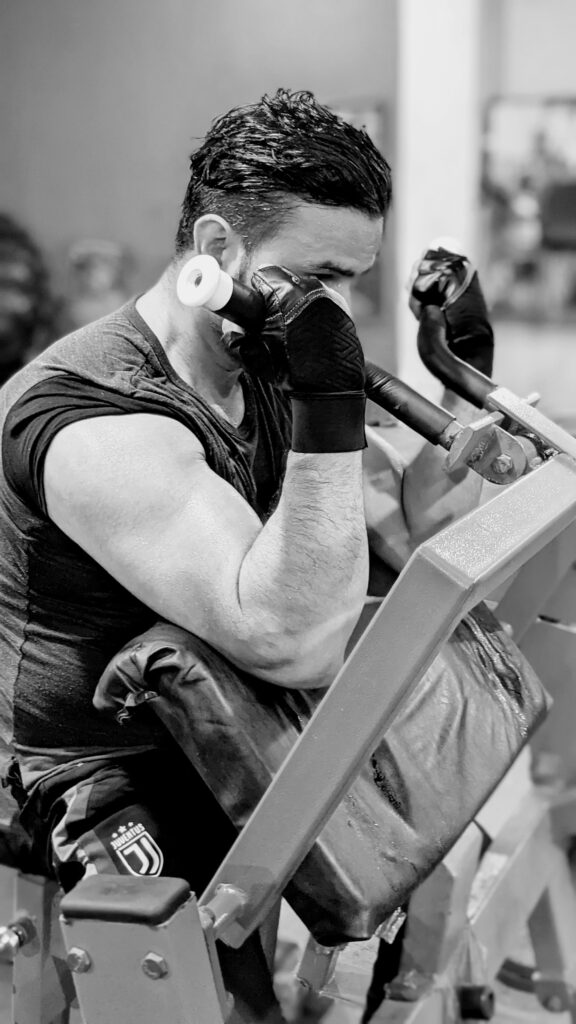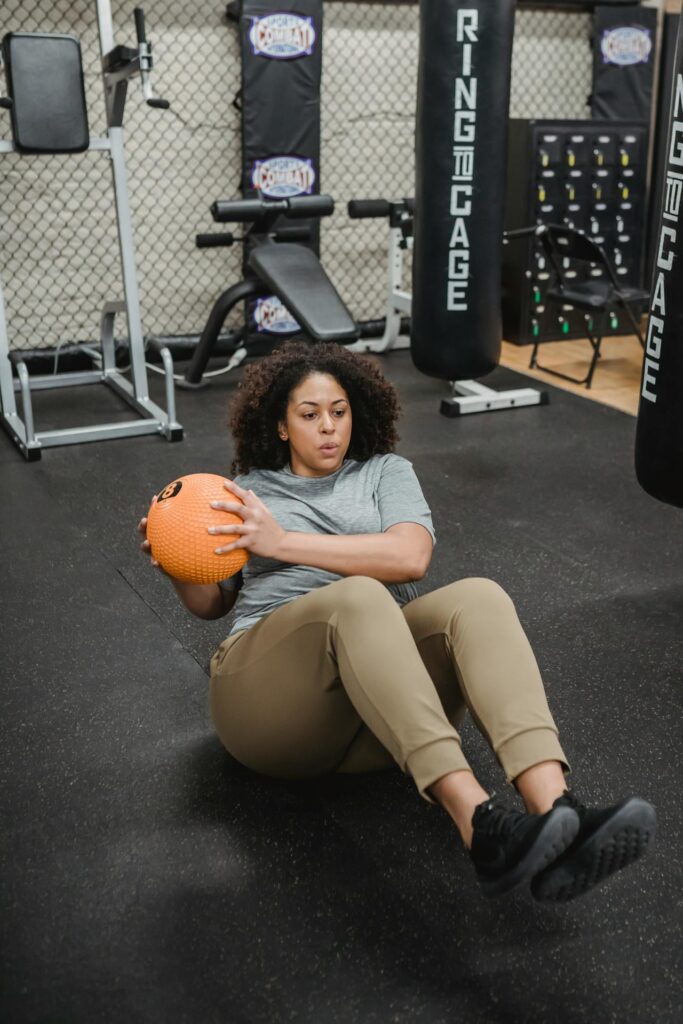If I asked you to show me someone who’s physically strong, there’s a good chance you’d point to someone with big muscles, maybe a bodybuilder or someone lifting serious weight at the gym. And you’d be right!
Now, I want you to picture a professional mover. They’re strong too, but their strength looks a little different than the person above. Their strength is more functional than visual- they’re moving awkwardly-sized furniture, twisting up stairs and narrow hallways, and bending over at weird angles.
Both of these people are strong, but their strength looks different and each has its own purpose. This is the difference of traditional strength training vs functional strength training! Both of these ways to train take hard work, even if they have different approaches. There isn’t one way to strength train that’s for everybody.
But how do you know the difference, and how do you know which one is right for you? Let’s dive in:
A Brief History of Strength Training
The idea of strength training for competitions (like the Olympics) has been around for a long time, but the idea of training for general health is still a relatively new concept in our history. As jobs have become more sedentary over the last century, many have found the need to intentionally schedule fitness since they aren’t getting it from their day-to-day lives.
Regular exercise for general health reasons wasn’t really a thing until the 1950s. Weightlifting took even longer to gain popularity. It didn’t happen until the late 1970s/early 1980s when bodybuilders like Arnold Schwarzenegger found wider popularity. Many people tried to emulate those strength celebrities and adopt training programs like theirs. The way these bodybuilders trained became the template for strength training programs around the world as more people started going to the gym.
What is traditional strength training?
Now that there are other styles, the bodybuilding style of training is now known as traditional strength training. While bodybuilding as a sport is its own separate thing, here I use bodybuilding to refer to programs that target muscle growth (also known as hypertrophy). This is the idea that if you’re lifting weights, you’re aiming for your muscles to not only get stronger but also look visually bigger.
Before I talk more about that, there are two important strength training terms here that you need to know:
Vocab Lesson
1. Compound Exercises: These are exercises that engage multiple muscle groups and joints at the same time, also referred to as multi-joint movements. Compound exercises usually refer to the major exercises listed below because of their ability to pack on a ton of weight.
- Examples: squats, deadlifts, pull ups, bench press
2. Isolation Exercises: These are exercises that target one specific muscle or muscle group, also known as single-joint movements.
- Examples: bicep curls, calf raises, tricep extensions
Compound exercises are used in both traditional and functional strength training. They are exercises that help you get really strong because they allow you to lift the most weight. Think about the people who do squats and deadlifts with many hundreds of pounds.

Traditional = Isolation Exercises
One of the main differences between traditional and functional strength training is the focus that traditional strength training puts on isolation exercises. For bodybuilding-style programs, you want each individual muscle to stand out and look bigger. These programs focus on targeting each of these muscles in different ways to achieve the most growth possible.
Because of this attention to isolated muscles, many bodybuilding programs are split into areas of the body. You might’ve heard people reference their workout using terms like “leg day,” “back day,” “arm day,” etc. This is so you can focus on a muscle group and train it with multiple exercises.
I like to think of traditional strength training as muscle-based training: your focus is on the muscles themselves, not what they do.
Getting Bulky
The prevalence of traditional strength training training feeds into the common myth that strength training makes you bulky. This myth has turned many people away from regular strength training because it doesn’t align with their goals. Traditional training programs are significantly more common than functional training programs, and many people adopt a training program without knowing the effect it will have on their body.
In actuality, it takes a lot of work and dedication to get those bigger muscles. Getting bulky just by using a traditional strength training program is unlikely. I’m not an expert on traditional strength training, so I’ll leave that to the pros! There’s a lot of traditional strength training information you can find online and in fitness books.
But what if you want to get stronger, but you’re not looking to train like a bodybuilder at all?
What Is Functional Strength Training?
It wasn’t until the 1990s that “functional fitness” became a term. Even then, it took a long time to gain popularity as a separate idea.
Functional training has become more popular because many people are looking for exercise that helps them move better. While many are still interested in muscle growth, there’s a large part of the population pushing for lifelong health and movement. They want training to match those goals.
I like to think of functional strength training as movement-based training- your focus is on what the muscles do (their function), not on the muscles themselves or aesthetics like traditional strength training. Movements like walking, bending, and carrying are all full-body movements that can be trained and strengthened by lifting weights.
Movement Patterns
In functional strength training, the focus is on movement patterns- all the different ways your body can move. In programs, you see things like “push day,” “squat day,” etc. instead of parts of the body. You’ll do more unconventional exercises and use different equipment than you see in most traditional strength training programs. Functional exercises mimic movements you do in everyday life like squatting, bending, pushing, pulling, carrying, crawling, jumping, twisting, and more.
Functional strength training focuses much more on compound exercises. We talked about compound exercises above as a set of specific exercises like the bench press and deadlift. I like to think of the more unconventional functional exercises as “full-body exercises” to keep them straight and acknowledge their different uses.
Full-Body Exercises
Our bodies don’t generally move in isolation unless we do it on purpose, like in traditional strength training. When we do tasks in real life, we’re using our whole body to do it. For example, when I’m picking something up, I’m bending with my legs, stabilizing with my core, and pulling with my arms. Functional training aims to put those pieces together and help your body work as one, instead of parts moving separately.
Why does this seem so different from traditional strength training? An important part of traditional training is using specific exercises and higher weights. The Freedom of Motion Principle states that the more movement you have in an exercise, the less weight you’ll be able to use. Essentially, you can’t lift really heavy and train different ways of moving like twisting at the same time. You need incredible stability to lift heavy weights, and you need lighter weights to allow for more movement.
Functional strength training is what I specialize in, so I’m going to give you two different examples of why this type of strength training is beneficial for you:
The Warehouse:
I worked at an Amazon warehouse for a while. There were signs all over my warehouse to lift in two steps- pick up the box first, then turn your whole body to put it in a delivery bag. Even in our training, we were reminded to use this two step process. This instruction exists because people kept twisting to put away boxes and hurting themselves.
When you training functional movements like twisting, you develop those muscles to support your body. So you can twist and put away a box without hurting yourself. Twisting isn’t a bad thing, but you want to make sure you’re giving your body the support it needs to move.
Many people use functional training as a way to prevent injury if they move in a weird way- think back to the example about moving furniture. If those muscles are strong, you can do it no problem! But if you don’t train that way, your body isn’t used to those movement patterns and you’re more prone to injuring yourself.
Floor Sitting:
Not too long ago I was in Target waiting for a friend in the dressing room. I sat down on the floor (I am a true floor person, after all). A woman sitting on a bench a ways down from me offered me the spot next to her, but I said I was comfortable. She told me that if she got on the ground like that, she’d never be able to get back up again. Now this woman couldn’t have been older than 45-50. She has decades of life left and already struggles to get up off the ground.
In fact, this is a movement pattern that many people struggle with. Being able to stand up from the ground is a huge indicator of how well you’ll be able to move as you age. Functional training includes things ground-to-standing exercises that help people train important everyday movements.
Traditional Strength Training vs Functional Strength Training: A Quick Recap
Traditional Strength Training:
- muscle-based training
- focus in on muscle growth (hypertrophy)
- uses isolation exercises
- common equipment used: dumbbells, barbells, machines
Functional Strength Training:
- movement-based training
- focus is on moving better
- uses full-body exercises
- common equipment used: dumbbells, kettlebells, sandbags, medicine balls
So… which is better?
Traditional or functional strength training?
Neither! Both! The reality is while they are different approaches to strength training, there’s a lot of in-between. You can find functional bodybuilding plans or create workouts that are half movement-focused and half muscle-focused.
The idea is to understand and identify the differences so you can choose what goes best with your goals. You’re able to look at a program and understand what goals it will help you reach. You have the power to choose what you really want from a strength training program, which means you’re more likely to see the results you want and stick with it!
Knowing the difference gives you the power to look past what’s trending and choose the results you want.
I do firmly believe, even if your goal is bodybuilding, that at least a little bit of functional training is good for everyone. In my programs, I follow the RGB Strength System I created to help people get strong, where the R stands for “real-life strength.” Training those full-body movements like standing up from the ground, bending, twisting, and reaching can have a positive impact on your movement for years or decades to come.
If you’re interested in learning more about functional training:
-> Read about the five basic functional strength training exercises here and learn how to do them in Full-Color Foundations, my five-week beginner strength group program.
-> If you have a good feel for the basic exercises, Colorful Strength goes more in-depth with functional training and helps you get strong in all directions.
Sarah Siertle
Hey! I'm Sarah!
I'm an inclusive strength & movement coach who helps people get hella strong so they can have fun and live their lives in full color!
My coaching is beginner-friendly, movement-based, and size-inclusive. I believe in coaching that is kind, not shaming or judgmental as so many fitness experiences are.
If you're ready to start your strength journey, you can check out your training options or get five days of five-minute workouts for free!



Comments